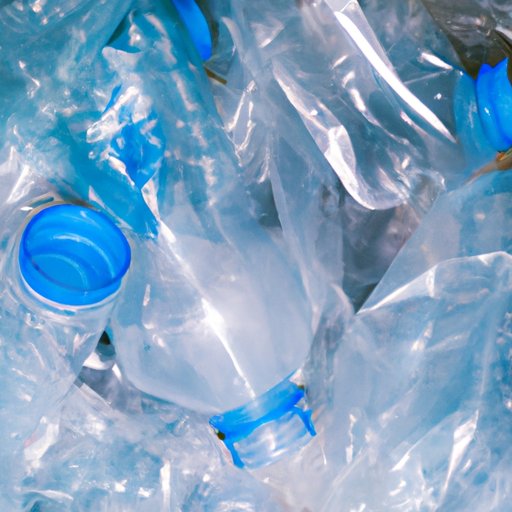Introduction
Plastic pollution is a growing problem worldwide, with adverse environmental, health, and economic impacts. Plastics are ubiquitous, found in products ranging from food packaging to electronics, toys to automobiles, and everything in between. Unfortunately, the durability of plastic has resulted in it becoming a ubiquitous pollutant, an ever-present threat to the land, water, and wildlife that we rely on. This article explores why plastic is bad for the environment, examining its overall impact on ecosystems, resource depletion, animal welfare, health hazards, and pollution, and providing some possible solutions to address the problem.
The Overall Impact of Plastic on the Environment
Plastic is harmful to the environment in different ways, from its manufacturing and production, disposal and waste management, depletion of natural resources, and impact on animal welfare.
Manufacturing and Production
One of the most significant impacts of plastic on the environment is its high energy consumption and greenhouse gas emissions, contributing to climate change. The plastic production process requires a large amount of energy and resources, including oil, natural gas, and coal, as well as water and chemicals. Moreover, the manufacturing process itself generates significant greenhouse gas emissions, mainly from the combustion of fossil fuels used to power production plants.
Disposal and Waste Management
The disposal of plastic waste can also have severe environmental impacts, particularly when it comes to landfills. Plastics take years, even centuries, to decompose fully, meaning they accumulate in landfills, continually taking up space and damaging local ecosystems. Moreover, there is the risk of groundwater contamination, with chemicals leaching from plastics into soil and water sources.
Resource Depletion
The production and consumption of plastic not only pollute the environment but also depletes the earth’s natural resources, contributing to environmental degradation and climate change.
Natural Resources Used in Plastic Production
One of the primary resources used in plastic production is oil. It makes up a significant proportion of the raw materials used in making plastics, and its extraction can have adverse environmental consequences. Methods such as fracking, for example, have resulted in ground level ozone pollution and contaminated ground and surface water sources.
Alternatives to Plastic
While some plastics have a range of advantageous properties, including durability and flexibility, there are many sustainable alternatives to plastic that can help reduce the impact on the environment. For instance, textiles made from organic cotton or recycled fibers could replace polyester and other synthetic fabrics, while glass or stainless steel containers could be used instead of plastic-based ones.
Animal Welfare
Another critical issue when it comes to plastics and the environment is the impact on animal welfare.
Impact of Plastic on Wildlife
Plastic pollution poses a severe threat to many animals’ survival. Marine wildlife, in particular, are at risk, with sea turtles, dolphins, and seabirds often harmed by plastic debris in the ocean. This has compounded effects on their health, growth, and ability to reproduce.
Oceans and Aquatic Ecosystems
Plastic also threatens aquatic ecosystems’ health, contributing to habitat destruction, coastal erosion, and pollution. It chokes natural waterways, disrupts marine food webs, and increases the risk of toxins being released into the water, which can be harmful to other wildlife and humans.
Health Hazards
Plastic’s environmental impact is much-discussed, but it also poses significant health hazards to human beings.
Chemicals in Plastic
Chemicals used in the production process of plastic materials can pose many health risks, including carcinogenicity, hormone disruption, and developmental effects on fetuses and children.
Microplastics
Microplastics pose a significant health risk to people. They are small plastic particles that can enter the human body through various pathways, such as through the food chain, cosmetics, water supply, and air. They also release toxic substances that can cause health problems, such as inflammation, damage to cells and organs, and even cancer.
Pollution
Plastic pollution has become an environmental and public health problem, with implications for the climate, ecology, and the economy.
Plastic Waste in Oceans
Plastic waste in oceans affects marine animals, with plastic pieces mistakingly ingested by animals, leading to starvation, entanglement, and toxicity. This has a profound impact on the ocean’s biodiversity and the ecological balance of the marine environment.
Landfill Pollution and Waste Management
Landfills are a problem because they take up space and release pollutants that harm the surrounding environment. Plastics are particularly problematic since they can persist for hundreds of years, releasing hazardous chemicals and leaching into groundwater systems.
Possible Solutions
Reducing plastic dependence offers many positive benefits for the environment and human health, and many solutions exist that can help reduce the impact of plastic on the environment.
Reducing Plastic Dependence
Individuals can make changes in their own lives to reduce plastic use. Simple lifestyle choices such as using reusable bags, water bottles, and recycling plastic material help reduce the demand for plastic.
Alternative Materials
Creating alternatives to plastics requires innovative engineering solutions to find new materials that are more sustainable, durable and cost-effective than plastic. Some of these alternative materials include glass, paper, bamboo, and organic cotton.
Conclusion
Plastic pollution is a real issue that negatively impacts our environment and world economy. It affects people’s health and the ecosystem’s biodiversity, and impacts animal welfare and the natural resources used for its production. Therefore, it is essential to take action to reduce and eventually eliminate the plastics we use daily. We all need to take responsibility for this global crisis and make an effort to protect the environment for future generations.
